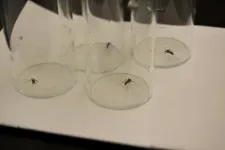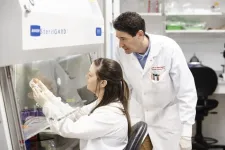(Press-News.org) Prime editing, a versatile form of gene editing that can correct most known disease-causing genetic mutations, now has a new vehicle to deliver its machinery into cells in living animals.
A team of researchers at the Broad Institute of MIT and Harvard has engineered virus-like particles to deliver prime editors to cells in mice at a high enough efficiency to rescue a genetic disorder. In the new work published today in Nature Biotechnology, the team adapted engineered virus-like particles (eVLPs) that they had previously designed to carry base editors — another type of precision gene editor that makes single-letter changes in DNA.
Now the researchers describe how they re-engineered both eVLPs and parts of the prime editing protein and RNA machinery to boost editing efficiency up to 170 times in human cells compared to the previous eVLPs that deliver base editors. The team used their new system to correct disease-causing mutations in the eyes of two mouse models of genetic blindness, partially restoring their vision. They also delivered prime editors to the mouse brain, and did not detect any off-target editing.
“This study represents the first time to our knowledge that delivery of protein-RNA complexes has been used to achieve therapeutic prime editing in an animal,” said David Liu, senior author of the study and Richard Merkin Professor and director of the Merkin Institute of Transformative Technologies in Healthcare at the Broad. Liu is also a Howard Hughes Medical Institute investigator and a professor at Harvard University.
Delivery dilemma
Gene editing approaches promise to treat a range of diseases by precisely correcting genetic mutations that cause disease. Prime editing, described in 2019 by Liu’s group, can make longer and more diverse types of DNA changes than other types of editing. However, delivering the complex gene editing machinery to cells in living animals has been challenging.
The prime editing system has three components: a Cas9 protein that can nick DNA; an engineered prime editing guide RNA (pegRNA) that specifies the location of the edit and also contains the new edited sequence to install at that location; and a reverse transcriptase that uses the pegRNA as a template to make specific changes to the DNA.
Researchers have used a variety of methods to deliver these molecular machines to cells, including lipid nanoparticles and viruses. Virus-like particles (VLPs), composed of a shell of viral proteins that carry cargo but lack any viral genetic material, have also been of particular interest. But VLPs have traditionally yielded modest delivery outcomes in animals, and have to be specifically engineered for each different type of cargo to efficiently deliver to cells.
“We initially hoped that we could just take the eVLPs that we had painstakingly developed and optimized for base editing and apply them to prime editors,” said Meirui An, a graduate student in the Liu lab and first author of the new paper. “But when we tried that, we observed almost no prime editing at all.”
Bottleneck breakthroughs
In the new work, the researchers extensively re-engineered both the eVLP proteins and the prime editing machinery itself so that both the delivery and editing systems worked more efficiently. For instance, they improved how the prime editing cargo was packaged in the eVLPs, how it was separated from the delivery vehicle, and how it was delivered into the target cells’ nuclei.
“The prime editor cargo must be efficiently packaged into eVLPs when the particles form but must also be efficiently released from the particles after target cell entry,” said Aditya Raguram, a former Liu lab graduate student and co-author of the study. “All of these steps have to be carefully orchestrated in order to achieve efficient eVLP-mediated prime editing.”
While each individual improvement led to small jumps in the efficiency of the prime editors, the changes together had a much larger impact.
“When we combined everything together, we saw improvements of roughly 100-fold compared to the eVLPs that we started with,” said Liu. “That kind of improvement in efficiency should be enough to give us therapeutically relevant levels of prime editing, but we didn’t know for sure until we tested it in animals.”
In vivo tests
Liu and his colleagues, in collaboration with Krzysztof Palczewski of the University of California, Irvine, first tested the system in mice to correct two different genetic mutations in the eyes. One mutation, in the gene Mfrp, causes a disease called retinitis pigmentosa that leads to progressive retinal degeneration. The other, in the gene Rpe65, is associated with blindness seen in the condition known as Leber congenital amaurosis (LCA) in humans.
In both instances, the eVLPs corrected the mutation in up to 20 percent of the animals’ retina cells, partially restoring their vision.
The research group also showed that the eVLPs loaded with prime editing machinery could effectively edit genes in the brains of living mice. Nearly half of all cells in the cortex of the brain that received the editing machinery showed a gene edit.
“The gene editing field largely agrees that, moving into the future, gene editing machinery should ultimately be delivered as proteins to minimize potential side effects and we’ve now shown an effective way to do that,” said Liu. “We plan to continue to actively work on improving eVLPs and adapting the technology to target other tissue types within the body.”
Funding:
Support for the study was provided in part by the National Institutes of Health, the Bill and Melinda Gates Foundation, the Howard Hughes Medical Institute, Foundation Fighting Blindness, the UC Irvine School of Medicine Dean’s office, a Research to Prevent Blindness unrestricted grant, and a National Science Foundation Graduate Research Fellowship.
Paper cited:
An, M. et al. Engineered virus-like particles for transient delivery of prime editor ribonucleoprotein complexes in vivo. Nature Biotechnology. Online January 8, 2024. DOI: 10.1038/s41587-023-02078-y
About Broad Institute of MIT and Harvard
Broad Institute of MIT and Harvard was launched in 2004 to empower this generation of creative scientists to transform medicine. The Broad Institute seeks to describe the molecular components of life and their connections; discover the molecular basis of major human diseases; develop effective new approaches to diagnostics and therapeutics; and disseminate discoveries, tools, methods and data openly to the entire scientific community.
Founded by MIT, Harvard, Harvard-affiliated hospitals, and the visionary Los Angeles philanthropists Eli and Edythe L. Broad, the Broad Institute includes faculty, professional staff and students from throughout the MIT and Harvard biomedical research communities and beyond, with collaborations spanning over a hundred private and public institutions in more than 40 countries worldwide.
END
Researchers engineer in vivo delivery system for prime editing, partially restoring vision in mice
By adapting virus-like particles to carry the machinery for a type of gene editing called prime editing, scientists have corrected disease-causing mutations in animals and increased editing efficiency.
2024-01-08
ELSE PRESS RELEASES FROM THIS DATE:
Three iron rings in a planet-forming disk
2024-01-08
The origin of Earth and the Solar System inspires scientists and the public alike. By studying the present state of our home planet and other objects in the Solar System, researchers have developed a detailed picture of the conditions when they evolved from a disk made of dust and gas surrounding the infant sun some 4.5 billion years ago.
Three rings hinting at two planets
With the breathtaking progress made in star and planet formation research aiming at far-away celestial objects, we can now investigate the conditions in environments around young stars and compare them to the ones derived for the early Solar System. Using the European Southern Observatory’s (ESO) Very Large ...
More than thirty new species of bacteria discovered in patient samples
2024-01-08
Unknown germs are a common occurrence in hospitals. Researchers at the University of Basel have spent many years collecting and analyzing them. They have identified many new species of bacteria, some of which are significant for clinical practice.
Bacterial infections can be treated more efficiently if the cause of the disease is known. In most cases, all it takes to identify a pathogen is an analysis in a medical laboratory. Sometimes, however, the standard methods are insufficient – for example, if the species of bacteria has not yet been classified or ...
Where do patients choose to undergo breast cancer surgery, and do these choices drive health care inequality?
2024-01-08
Including patients as partners for making decisions about their medical treatments is an important aspect of patient-centered care. A new study from England examined choices that patients with breast cancer make when considering where to have surgery for their condition and assessed how policies that offer such choices might affect inequalities in the health care system. The findings are published by Wiley online in CANCER, a peer-reviewed journal of the American Cancer Society.
For the study, investigators analyzed data from the National Health Service (NHS), the publicly ...
Some mosquitoes like it hot
2024-01-08
Certain populations of mosquitoes are more heat tolerant and better equipped to survive heat waves than others, according to new research from Washington University in St. Louis.
This is bad news in a world where vector-borne diseases are an increasingly global health concern. Most models that scientists use to estimate vector-borne disease risk currently assume that mosquito heat tolerances do not vary. As a result, these models may underestimate mosquitoes’ ability to spread diseases in a warming world.
Researchers led by Katie M. Westby, a senior scientist at Tyson Research Center, Washington ...
Out-of-pocket cost increase could put HIV prevention medications out of reach
2024-01-08
PHILADELPHIA – Increasing patients’ out of pocket costs for HIV pre-exposure prophylaxis (PrEP), medications, which have been shown to dramatically reduce the risk of HIV infection, could lead to a significant reduction in PrEP use and a rise in HIV infection rates, according to a new study co-led by researchers at the Perelman School of Medicine at the University of Pennsylvania and Johns Hopkins Bloomberg School of Public Health.
The study, published today in Health Affairs, was designed, in part, to explore the impact that out-of-pocket cost increases could have, depending on the outcome of an ongoing court case challenging certain ...
Survey finds majority of Americans think bariatric surgery is a shortcut to losing pounds, should only be a last resort
2024-01-08
Orlando, Fla - More than two in five U.S. adults suffer from obesity, an epidemic that continues to trend upward. While bariatric surgery is an extremely effective treatment option, a new national survey by Orlando Health reveals common stigmas that may deter those who qualify for surgery from pursuing the treatment they need.
“Treatment plans for obesity are tailored to each individual patient based on things like body mass index and existing medical conditions and may include medication, lifestyle changes, counseling and bariatric surgery,” said Andre Teixeira, MD, medical ...
First ever scientific study on First World War crater reveals new details on its history
2024-01-08
The spectacular explosion of the mine at Hawthorn Ridge – a fortified German front-line position in the First World War – marked the beginning of the Battle of the Somme, and remains one of the best-known pieces of film from the whole conflict.
More than 60ft below the surface, British miners had dug a gallery for more than 900 metres from their lines and packed it with 40,000 lbs of explosives. It was one of 19 mines placed beneath German front positions that were detonated on 1st July, 1916 to mark the start of the offensive.
But the detonation of the ...
Blood flow changes in the eyes could influence visual symptoms of migraines
2024-01-06
A recent study found changes in blood flow in the retina could explain why some migraine patients experience visual symptoms. The findings could represent a long-sought observable marker for migraines that doctors can use to aid in the clinical treatment of the condition.
While patients with migraines often experience symptoms such as pain around the eye, sensitivity to light, blind spots and visual blurring, the mechanisms behind those symptoms have not been well understood. UCLA Health researchers used a non-invasive imaging technique, known as optical coherence tomography angiography, or OCTA, ...
Global scientific network highlights plant genera named for women
2024-01-06
A network of scientists across the globe have identified more than 700 plant genera named for women. This is a nearly twenty-fold increase in the number of genera linked to women before the group started working on the list.
The project, which aimed to highlight the contribution of women to botany, was the result of social media conversations about plants named for people.
What began as a simple question about how many and which plant genera were named for women evolved into a global network of scientists who built ...
UofL researchers are unmasking an old foe’s tricks to thwart new diseases
2024-01-05
When the body encounters bacteria, viruses or harmful substances, its innate immune cells, neutrophils, assemble at the site to combat the invader.
Bacteria and viruses have ways to avoid these defenses, however. Yersinia pestis, the bacteria that causes bubonic and pneumonic plague, for example, can hide from the immune system, allowing it to replicate in the body unhindered until it can overwhelm the host. This ability allowed Y. pestis to spread bubonic plague across Europe in the 14th Century, killing a third of the European population.
While plague may not be a serious threat to human health in modern times, researchers at the University of Louisville are studying Y. ...
LAST 30 PRESS RELEASES:
Numbers in our sights affect how we perceive space
SIMJ announces global collaborative book project in commemoration of its 75th anniversary
Air pollution exposure and birth weight
Obstructive sleep apnea risk and mental health conditions among older adults
How talking slows eye movements behind the wheel
The Ceramic Society of Japan’s Oxoate Ceramics Research Association launches new international book project
Heart-brain connection: international study reveals the role of the vagus nerve in keeping the heart young
Researchers identify Rb1 as a predictive biomarker for a new therapeutic strategy in some breast cancers
Survey reveals ethical gaps slowing AI adoption in pediatric surgery
Stimulant ADHD medications work differently than thought
AI overestimates how smart people are, according to HSE economists
HSE researchers create genome-wide map of quadruplexes
Scientists boost cell "powerhouses" to burn more calories
Automatic label checking: The missing step in making reliable medical AI
Low daily alcohol intake linked to 50% heightened mouth cancer risk in India
American Meteorological Society announces Rick Spinrad as 2026 President-Elect
Biomass-based carbon capture spotlighted in newly released global climate webinar recording
Illuminating invisible nano pollutants: advanced bioimaging tracks the full journey of emerging nanoscale contaminants in living systems
How does age affect recovery from spinal cord injury?
Novel AI tool offers prognosis for patients with head and neck cancer
Fathers’ microplastic exposure tied to their children’s metabolic problems
Research validates laboratory model for studying high-grade serous ovarian cancer
SIR 2026 delivers transformative breakthroughs in minimally invasive medicine to improve patient care
Stem Cell Reports most downloaded papers of 2025 highlight the breadth and impact of stem cell research
Oxford-led study estimates NHS spends around 3% of its primary and secondary care budget on the health impacts of heat and cold in England
A researcher’s long quest leads to a smart composite breakthrough
Urban wild bees act as “microbial sensors” of city health.
New study finds where you live affects recovery after a hip fracture
Forecasting the impact of fully automated vehicle adoption on US road traffic injuries
Alcohol-related hospitalizations from 2016 to 2022
[Press-News.org] Researchers engineer in vivo delivery system for prime editing, partially restoring vision in miceBy adapting virus-like particles to carry the machinery for a type of gene editing called prime editing, scientists have corrected disease-causing mutations in animals and increased editing efficiency.





